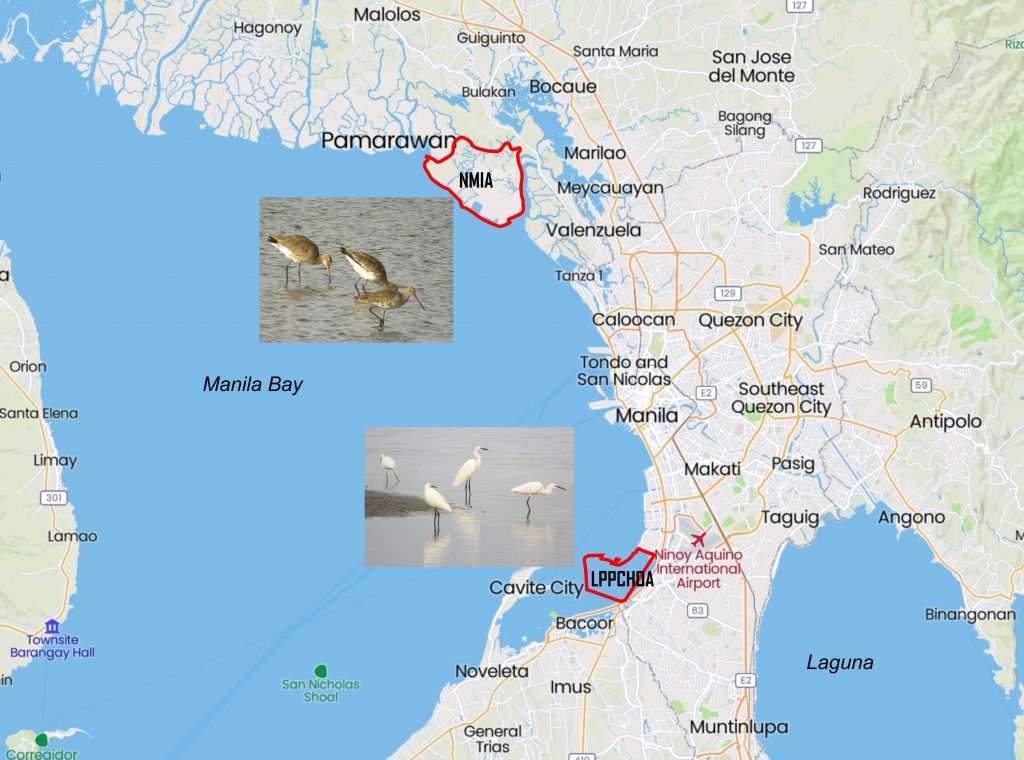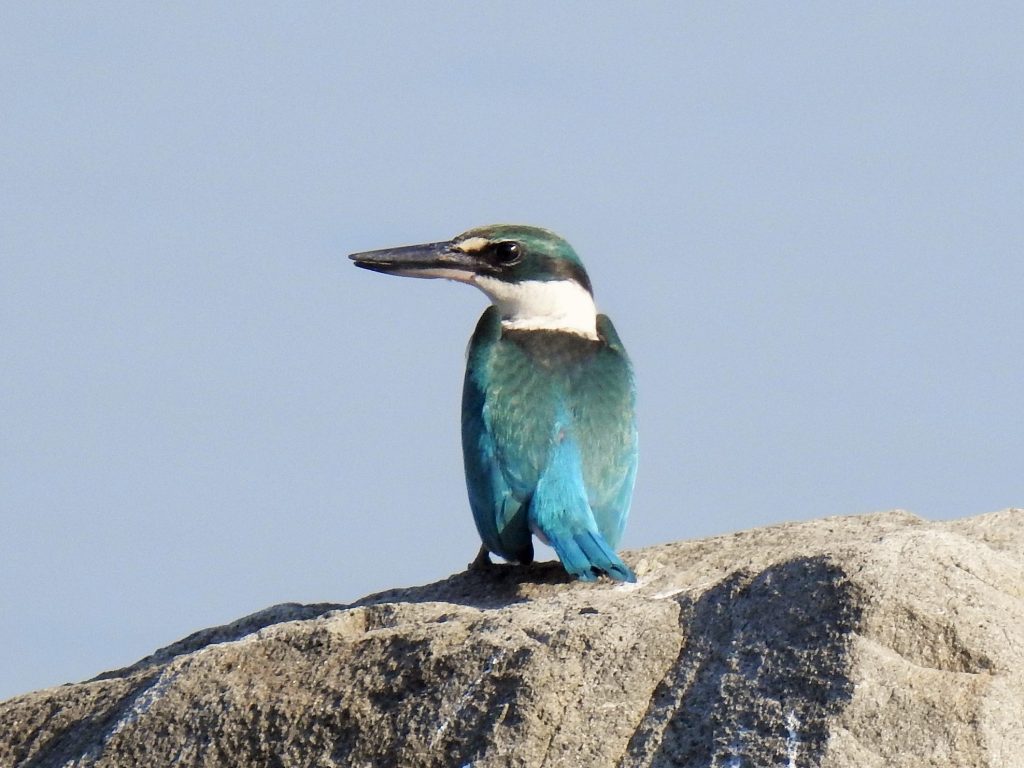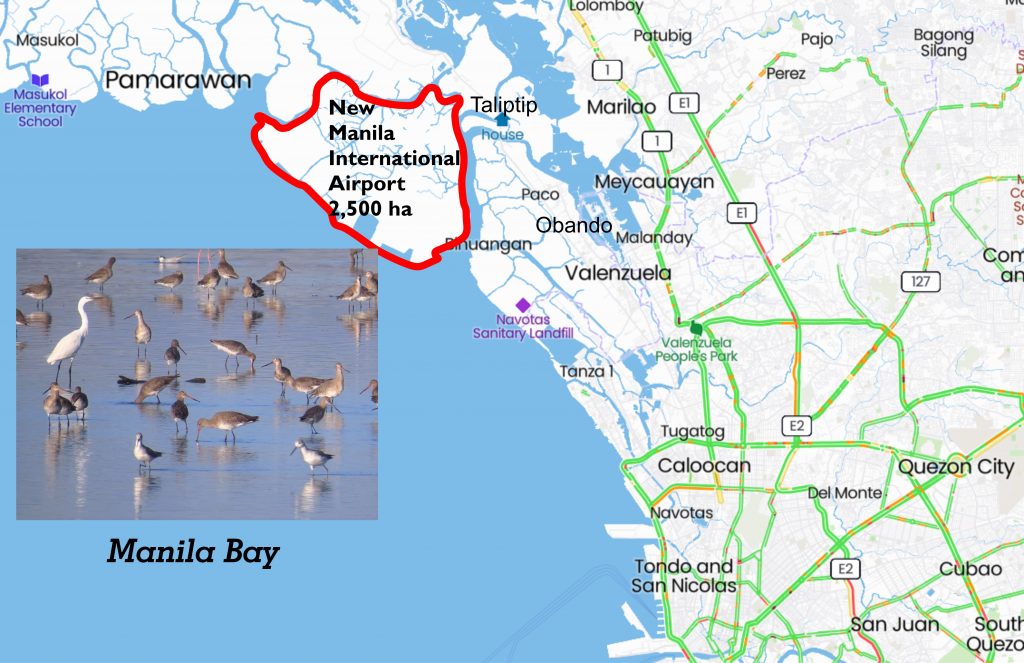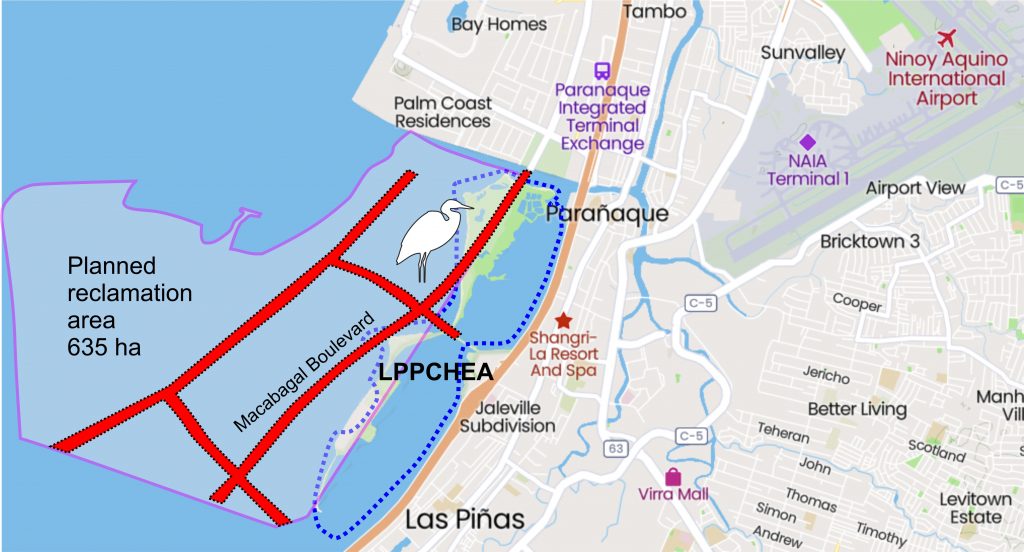Blog 10.3.2021, Irynn Abano
Airport projects are destroying Manila Bay bird wetlands
In the Philippines, awareness of birds is growing, but the government is acting inconsistently. The government gave permission to build a huge new airport on the shores of Manila Bay that would destroy the habitat of thousands of wetland birds. Another expansion project would fragment a UNESCO wetland conservation site.

Last month, my Finnish friend Riitta Vartti chat me up: Thank you for all those birds and flowers that you share (on Facebook). I share photos of birds from the Facebook page of Wild Bird Club of the Philippines (WBCP where I am a member[1]), the groups Wild Bird Photographers of the Philippines, the Katipunan Wild Community, Birdwatch Philippines Community and pages of individual birders. It is my way of promoting knowledge about birds, knowing that urbanites have limited exposure to them.
Riitta also sent me the cover picture of Finnish Bird Life magazine. It showed “a rare bird in (their) latitudes” and surprise, surprise! – “a kingfisher that has been seen on a snowy tree in Helsinki.” So I wrote her back: lots of that common kingfisher (alcedo atthis) here distributed throughout the Philippines. But I have seen it only twice: during WBCP birdwatching events at the Las Pinas Paranaque Critical Habitat Eco-tourism Area (LPPCHEA) and more recently along the banks of Pasig River in Intramuros, Manila. My “suki” is the white-collared blue kingfisher (todiramphus chloris) – meaning I often see it around the UP Academic Oval where I took my week-end walks pre-Covid.

She messaged back: we have a big birdwatching event (that Jan 30-31 week-end), the BirdLife Suomi/Pihabongaus (birdlife.fi) – everybody counts birds in their backyard. Since 2006, Riitta said this was the way how they know the situation of their birds. Wow! So I wrote her back that the Asian Waterbird Census has been going on, with WBCP members taking part, that unfortunate me cannot join due to Covid 19 pandemic restrictions.
I also mentioned that in the Philippines, there is growing consciousness about birds but the government is very inconsistent. For example, the government gave the permit to build an airport, the Aerotropolis or New Manila International Airport, in Barangay Taliptip, Bulacan up to Sitio Baluarte, Obando, both in Bulacan province north of Manila. That will affect the wild birds that frequent Pamarawan Wetlands along Manila Bay 6.5 kilometers away, aside from fisheries, mangroves and livelihoods. I ended my message with GGGGrrrrrr![2] That caught her interest enough to request me to write a blog. She has been looking for someone to write on some environmental issue.

So this blog: To be honest, I started joining birdwatching for the sheer pleasure of it. As a child, I was hypnotized by mayas (Eurasian sparrow) going back and forth, with items to build their nest on eaves of neighbor’s houses or those Nanay (Mother) periodically shooed away from the mat where she dried newly-harvested palay (rice); birds circling the dome of churches, egrets pecking on the backs of carabaos (water buffalos) on rice paddies and swallows soaring around the green meadows of my childhood.
But thanks to WBCP: I learned how important birds are and how people do not know that and catch them to eat, as pets or worse to trade. More important, I learned how the government is not carrying out its mandate sufficiently or, worse, violating its mandate! According to RA 9147 (An act providing for the conservation and protection of wildlife resources and their habitats) Section 25: All designated critical habitats shall be protected, in coordination with local government units and other concerned groups, from any form of exploitation or destruction which may be detrimental to the survival of the threatened species dependent therein. https://www.officialgazette.gov.ph/2001/07/30/republic-act-no-9417/
I learned more about the importance of the environment for the birds and other fauna (and Homo sapiens, yes, us!) and flora. Like the wetlands that Dr. Annadel Cabanban, Wetlands International Philippines head, said are traditionally perceived as “wastelands and mosquito breeding grounds” thus disposable for coastal development and land reclamation. Such misperception has “dramatically reduced the amount and quality of habitat available to waterbirds…the ecosystem most in decline in the world…worst in Asia.”
Last month, the Department of Environment and Natural Resources (DENR)-led 2021 Waterbird Census[3] tallied 110,000 waterbirds. Of the 60 species counted in the Manila Bay census, more than two-thirds migrated from as far as Siberia and Alaska, all dependent on wetlands to survive. However, the results indicated almost 20% drop in migratory water birds in Manila Bay over two years! Less than fifteen totaled in internationally significant numbers. Did the 25,000 bird shortfall have any wetlands to go to?
DENR released the results in time for the World Wetlands Day last February 2, “to raise global awareness about the importance of wetlands for the people and the planet”. Ha-ha! Hu-hu-hu! So what do we in WBCP say? With 95,000 or 87% of the waterbirds counted in Bulacan, Pampanga and Bataan, North Manila Bay is one of the last Philippine wetlands refuge for these creatures so ‘No to more reclamation! No to San Miguel Corporation’s Bulacan Aerotropolis!”
I want to reiterate that the government not only does not carry out its mandate sufficiently; worse, it violates its mandate! For example, Arne Jensen, Wetlands International Associate Expert and WBCP records committee chair, said that Manila Bay, host to the most waterbirds among any Philippine wetlands, has less than 200 protected (1%) hectares while its habitats and birds confront numerous threats! Declining feeding grounds on tidal flats across their flyway account for the plunge in the numbers of long-distance shorebirds in Bulacan and gulls in the Pampanga rivers.
Reclamation in Tanza, Navotas, in Cavite and more are further decline foretold! WBCP’s President Mike Lu said that four of the bay’s 10 critical wetland sites, either nationally or internationally important, are being “developed” (airport development, Philippine Reclamation Authority (PRA)’s massive reclamation plans, Department of Public Works and Highways (DPWH)’s coastal embankment for flood mitigation from Bataan to Cavite, removal of wetlands through commercial dredging).
In fact, PRA is in varying stages of approving 25 reclamation projects, covering some 30,000 hectares, nearly half the size of Metro Manila[4], 4 with permits from local government units! 4 have already been approved in Metro Manila: one under construction and three have completed the public consultation phase. Outside NCR, three projects are under construction in Cavite and the Bulacan airport project has started.[5] Do these government agencies care that their “development projects” will add 14 more species “now either near threatened or directly threatened with extinction, lost forever in the world” including Black-faced Spoonbill (Platalea minor), Chinese Egret (Egretta eulophotes), Black-tailed Godwit (Limosa limosa), Asian Dowicher (Limnodromus semipalmatus) and Far Eastern Curlew (Numenius madagascariensis)?
The 635-hectare Las Pinas-Paranaque Coastal Bay Project reclamation for a new airport which would cut through the 175-hectare Freedom Island, a Ramsar site and a known spot for migratory birds has, so far, been stalled legally on the basis that this will “potentially cause irreparable damage to the Las Pinas Paranaque Wetland Park”, a declared protected area (RA 11038).[6] Already in 2012, news report on a plan to reclaim 600 hectares of sea behind the lagoon and recommended closure of Las Pinas-Paranaque Critical Habitat and Eco Tourism Area (LPPCHEA) because of possibilities of bird strikes at the Ninoy Aquino International Airport (NAIA) led WBCP warned that it would imperil the avian life in the coastal lagoon, home to an estimated 5,000 birds at peak of the migratory season and host to more than 80 species of birds, the highest in any site in Metro Manila; that there is no evidence that the LPPCHEA is in any way connected with any bird strikes; that In fact several airports around the world co-exist well with nearby sanctuaries and large bird populations, e.g. London Heathrow and Bangkok’s new Suvarnabhumi Airport, some of the busiest in the world.[7]

Government inconsistency is sobra (too much). In 2011, the Supreme Court issued a ruling protecting Manila Bay, directing government agencies and private entities to clean up, rehabilitate, preserve, restore and maintain the waters of the bay. In September 19, 2020, the DENR led the opening of the artificial white sand beach made of crushed dolomite on a stretch of Manila Bay’s shoreline along Roxas Boulevard. To mark International Coastal Clean-up Day! More haha! huhuhu! That dolomite, commonly used in construction, may pose hazards to humans and the environment. Government defended that bay beautification will “signify cleanliness’.[8] That area continues to be polluted despite intermittent rehabilitation efforts through the years.
Meanwhile, the 2021 Great Backyard Bird Count (GBBC) leapt out of my Facebook page from February 12-15! “when the world comes together for the love of birds” to “help scientists better understand global bird populations before one of their annual migrations”.[9] But there should still be pag-asa (hope in Filipino, also the name of the first Philippine eagle bred in captivity)! Jensen said that proper wetland management “has helped recover species and populations that were once in serious decline” in other countries. “Challenge and opportunity remain to act, given the inseparable connection of wetlands, water and our wellbeing”. Lu recommended to stop reclamation and to instead reorganize PRA and DPWH for restoration and climate change adaptation. Such will support global and national policies to implement nature-based solutions that maintain the wild bird habitats while also protecting people.” Abangan! (Let us watch what the government will come up with.)
[1] I also love sharing photos of native trees from the pages of members of the Philippine Native Plants Conservation Society Inc (PNPCSI) where I am also a member. I joined this first because birds need trees and local birds prefer native trees.
[2] https://businessmirror.com.ph/2020/07/26/bulacan-aerotropolis-project-goodbye-birds-hello-big-metal-birds/
[3] This Asian Waterbird Census in Manila Bay was part of the International Waterbird Count that Wetlands International coordinates globally in January every year. Dating back to 1967, this census covers over a hundred countries, one of the largest and longest-running biodiversity monitoring programs worldwide. It includes the provinces of Bataan (Balanga), Pampanga (Pasac and Pampanga River), Bulacan (coastal wetlands of Sta. Cruz, Pamarawan, Bambang and Taliptip), Cavite (Imus River mouth and Noveleta) and the National Capital Region (NCR) (Valenzuela fishponds, Tanza mudflats, Paranaque Wetlands Park). There was also a bird count in Candaba Marsh.
[4] Manila Bay is shared by five cities in Metro Manila and four coastal provinces. Land reclamation projects depend largely on their local government units. Past reclamation projects covered more than 600 hectares now made of commercial complexes including the country’s biggest mall, Mall of Asia, island business parks and residential complexes. Groups opposed to the 25 reclamation estimate these projects will affect some 10 million families.
[5] https://news.mongabay.com/2020/05/as-lockdown-ends-activists-brace-to-resume-fight-over-manila-bay-reclamation/
[6] Republic Act 11038 or the Expanded National Integrated Protected Areas System Act or E-NIPAS Act
[7] Internationally known Ornithologist and bird strike adviser to Scandanavia’s largest airport, Arne Jensen says “You don’t solve potential bird strikes in NAIA by trying to vacuum-clean Coastal Lagoon. There are more than 100,000 wetlands birds in Manila Bay moving from and back every day and every season and they can’t be eliminated. Further, each bird species/family requires different bird strike adaptation and mitigation strategies which NAIA has not fully developed yet. And if you don’t know the location and altitude of strikes and what species are causing problems, any extirpation attempt becomes absurd and a waste of money.” https://ebonph.wordpress.com/2012/10/03/wbcp-press-conference-on-bird-strikes/
[8] https://www.rappler.com/newsbreak/iq/things-to-know-dolomite-sand-affect-manila-bay
[9] This dates further back to 1998, launched by the Cornell Lab of Ornithology and National Audubon Society. It was the first online citizen-science project to collect data on wild birds and display these data in near real time, becoming a global project in 2013 when data was entered into eBird, the world’s largest biodiversity-related citizen science project.
References:
2021 Waterbird Census in Manila Bay shows 20% decline over 2 years, Feb 1 2021 https://businessmirror.com.ph/2021/02/01/2021-waterbird-census-in-manila-bay-shows-20-decline-over-two-years/
As lockdown ends, activists brace to resume fight over Manila Bay reclamation by Leilani Chavez, Susan Claire Agbayani, 25 May 2020 https://news.mongabay.com/2020/05/as-lockdown-ends-activists-brace-to-resume-fight-over-manila-bay-reclamation/
SC to tackle Manila Bay rehab case Nov 3, Oct 14 2020 https://www.pna.gov.ph/articles/1118499
Verafiles Fact Sheet: Who should clean our waste water?, Oct 26 2020 https://verafiles.org/articles/vera-files-fact-sheet-who-should-clean-our-wastewater
In 2008, the SC also resolved a mandamus case by ordering multiple government agencies to urgently act on the rehabilitation of the Manila Bay.
Press Release June 23, 20200 Villar to DENR: Bacoor reclamation project threatens protected area, undermines Manila Bay rehabilitation project and will worsen flooding http://legacy.senate.gov.ph/press_release/2020/0623_villar1.asp
https://www.officialgazette.gov.ph/2018/06/22/republic-act-no-11038/
WBCP Press conference on bird strikes, Anthony Arbias, Oct 3 2012 https://ebonph.wordpress.com/2012/10/03/wbcp-press-conference-on-bird-strikes/
https://www.officialgazette.gov.ph/2001/07/30/republic-act-no-9417/
https://www.rappler.com/newsbreak/iq/things-to-know-dolomite-sand-affect-manila-bay
Irynn Abano is Advocacy Officer of the Center for Migrant Advocacy and a member of Wild Bird Club of the Philippines (WBCP) and the Philippine Native Plants Conservation Society Inc. She is mother of 3 and a grandmother of 2.
